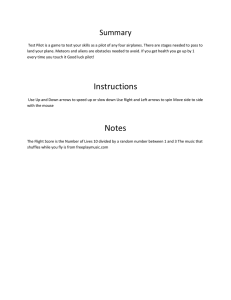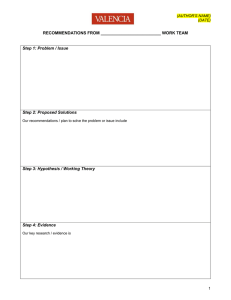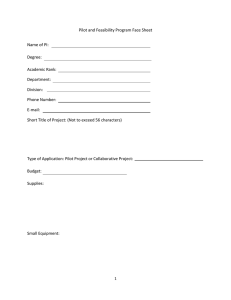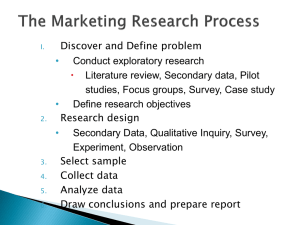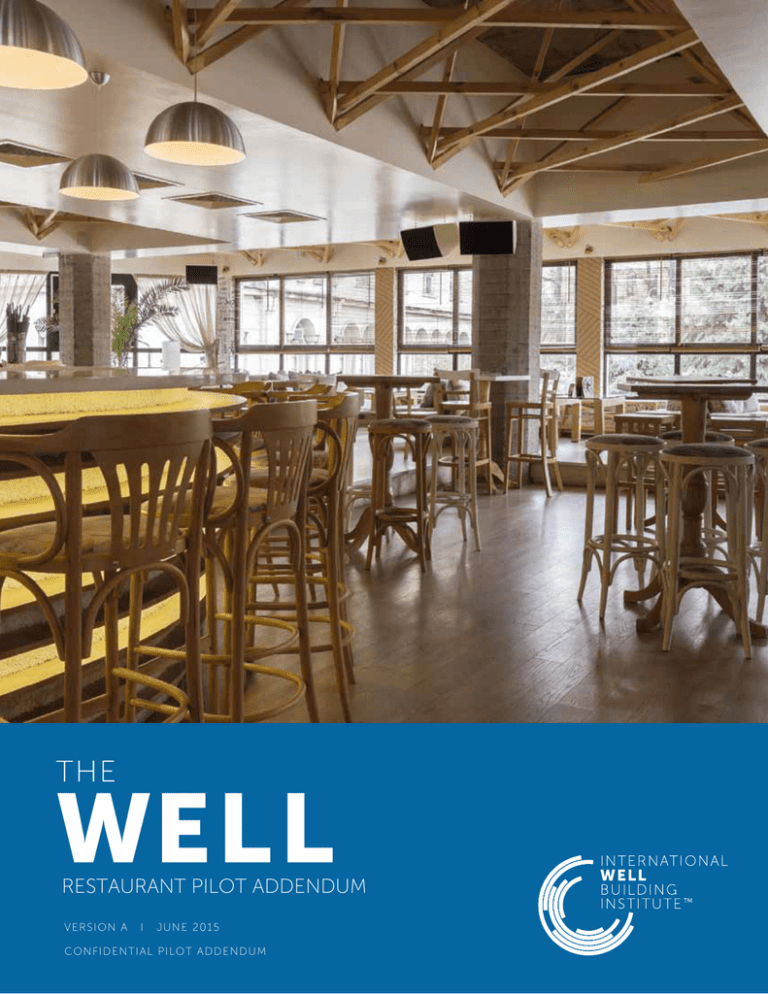
RESTAURANT PILOT ADDENDUM
VE R SI O N A
I
JU NE 2 01 5
CONFIDENTIAL
INFORMATION
CO N FI DE
NTI A L PI L O T
A DDENDU M
1
Copyright © 2015 by Delos Living LLC. All rights reserved.
This WELL Restaurant Pilot Addendum is a draft work in progress and constitutes confidential and proprietary information of Delos
Living LLC administered by the International WELL Building Institute, PBC (IWBI). You may not, at any time, directly or indirectly,
use, disclose, copy or otherwise make available to any other person or entity this WELL Restaurant Pilot Addendum, or any part
thereof, except as shall be expressly authorized by Delos Living LLC or the IWBI, in a writing signed by an authorized representative
of Delos Living LLC or the IWBI. All information contained herein is provided without warranties of any kind, either express or
implied, including but not limited to warranties of the accuracy or completeness of the information or the suitability of the
information for any particular purpose. Use of this document in any form implies acceptance of these conditions.
Confidential Pilot Addendum
2
WELL Building Standard®
Restaurant Pilot A
The WELL Pilot Program
The WELL Building Standard® Version 1.0 (WELL v1.0) was launched on October 20th, 2014 for the
Commercial and Institutional Office building sector. That standard applies to office spaces, where wellbeing is related to worker health, performance and motivation.
While positioned for office projects, large sections of the WELL Building Standard have applications
outside the office setting, although most building types require some modification. These differences
create the need for new WELL Pilot Programs. As such, the International WELL Building Institute™ (IWBI)
has begun creating Pilot Programs to test and refine how standards can best apply to new building
sectors. The IWBI will integrate the information and lessons learned from the WELL Pilot Program into
future versions of the WELL Building Standard, which will include specific Features, Parts, and
Requirements for new building sectors addressed by the pilots.
WELL Pilot Standards are developed by incorporating best practices for building design and by adapting
the current WELL Building Standard to new building uses. Over the course of a Pilot Program, the IWBI
will use information and feedback gathered from pilot projects and industry experts to further refine the
Pilot Standard prior to publication as part of the WELL Building Standard. A standard will move out of the
pilot phase and become a graduated standard, which refers to standards that are integrated into the
base WELL Building Standard. Graduated standards, by definition, are standards that have successfully
passed through pilot testing and are part of the published WELL Building Standard.
Certification of Pilots
Pilots may receive Silver, Gold or Platinum Pilot Certification.
To achieve Silver Pilot Certification, a project must satisfy 100% of all Preconditions as well as 20% of all
Optimizations. This differs from the WELL Building Standard due to the fact that the IWBI uses feedback
including which Features are selected as a basis for informing the eventual integration of pilot Features
into the WELL Building Standard.
Gold and Platinum Pilot Certification follow the same rules as with the WELL Building Standard: 100% of
all Preconditions must be met plus 40% of all Optimizations for Gold Pilot Certification or 80% of all
Optimizations for Platinum Pilot Certification.
WELL Pilot Certification is not guaranteed and will not be awarded until the IWBI verifies that all
necessary documentation and performance requirements are met.
Organization of Spaces
A space is defined as some or all of a building that is typified by a specific use or function. Spaces are tied
to specific WELL standards and can either be primary or secondary, as designated by the IWBI. All
projects are anchored by a primary space and follow its associated WELL standard. If the scope of a pilot
project includes a space that falls under the definition of an existing secondary space, then that project
must apply the secondary space standard alongside the primary space standard in order to achieve WELL
Pilot Certification.
This pairing system ensures that any distinct spaces within the project scope that may require unique
considerations will only be held to those requirements appropriate for that space. However, pairing
standards is required only when the WELL standards associated with the spaces are both of the same
Confidential Pilot Addendum
3
class: either both the standards are pilot standards, or both the standards are graduated (i.e., non-pilot)
standards. For more information, see the WELL Certification Guidebook for Pilot Projects.
Restaurant Spaces
Restaurants are primary spaces in the scope of the WELL Building Standard®. This means that it is
possible that the WELL Restaurant Standard could be applied across the entirety of a certified space.
However, this does not preclude the possibility that certain parts of the project may fall under the purview
of a secondary standard.
Most spaces that use the Restaurant Pilot Standard will need to likewise use the Commercial Kitchen Pilot
Standard, which refers to the commercial kitchen secondary space: the Restaurant Pilot Standard covers
only the consumer space, while the kitchen portion will have unique considerations relating to food
handling and preparation if those activities also occur on-site.
This Pilot Standard for Restaurants presents new content designed to provide improvements to dining
spaces.
The Restaurant space is applicable in locations where a consumer may purchase food
items and dine on the site, which may include indoor and/or outdoor seating. The
establishment may include waiting staff that tend to consumers, or may be self-serve.
The Restaurant space does not include take-out only establishments, nor does it
include establishments whose primary source of revenue derives from the sale of
alcoholic beverages. Further, the Restaurant Pilot Standard only applies to dining
spaces—it does not cover kitchens wherein food is prepared.
Americans are increasingly dependent upon restaurants and other prepared food for their nutritional
health. There are nearly one million restaurant locations in the United States, employing 14 million people
and providing a third of the nation’s total caloric intake. 1,2 Ensuring that restaurants have healthy,
nutritionally complete options and otherwise facilitate healthier consumption decisions is not merely a
matter of consumer choice; it’s an issue of public health.
The Restaurant Pilot Program addresses health and well-being issues specific to dining environments,
and the ambient conditions and design of such establishments which promote healthy eating habits.
Participating in the Pilot Program
The first step in creating a restaurant pilot project is to officially apply to the Pilot Program with the IWBI.
Projects must provide specific information to the IWBI for initial evaluation. The IWBI will conduct an
initial evaluation to ensure the project is appropriately categorized as a WELL Restaurant Pilot Project,
and if so, the IWBI will assign an agent to work closely with the project’s designated point of contact to
provide assistance and ensure that feedback can be carefully integrated into the pilot framework.
The goal of the WELL Pilot Program is to garner substantive feedback on elements outside the core of
the WELL Building Standard®. One benefit of registering as an early pilot is that the project will work with
1
Facts at a Glance. National Restaurant Association website. http://www.restaurant.org/NewsResearch/Research/Facts-at-a-Glance. Updated April 4, 2015. Accessed May 8, 2015.
2
Food-Away-from-Home. United States Department of Agriculture Economic Research Service website.
http://www.ers.usda.gov/topics/food-choices-health/food-consumption-demand/food-away-fromhome.aspx. Updated October 29, 2014. Accessed May 8, 2015.
Confidential Pilot Addendum
4
the assigned agent and the IWBI to establish guidelines and evaluate new Features and Parts for future
inclusion into the published WELL Building Standard.
How to Use Addenda with the current WELL Building Standard
This document presents the Pilot Standard as an addendum: a concise supplementary document that
makes clear how the current version of the WELL Building Standard uniquely applies to the building
sector. Projects can thus use the current version of the WELL Building Standard as the primary resource
and set of requirements along with the WELL Certification Guidebook for Pilot Projects, which clarifies
how proof of achievement is verified.
This addendum document describes the three differences between the pilot and the WELL Building
Standard:
1.
2.
3.
Parts that do not apply in any form to this pilot.
New Parts within existing Features that apply to this pilot.
New Features that apply to this pilot.
If an applicable Feature does not fall into the categories above, then the pilot project should follow the
Feature as described in the current version of the WELL Building Standard.
The following chart summarizes numbers 1 and 2 above by listing the existing applicable Parts, the
existing not applicable Parts, and the new Parts. It also describes the Feature level
(Precondition/Optimization) for this pilot, which may be different than in the published WELL Building
Standard.
Confidential Pilot Addendum
5
APPLICABILITY MATRIX
Level
Parts
Applicable
01 Air quality standards
PRECONDITION
123
02 Smoking ban
PRECONDITION
12
03 Ventilation effectiveness
PRECONDITION
123
04 VOC reduction
PRECONDITION
12345
05 Air filtration
PRECONDITION
123
06 Microbe and mold control
PRECONDITION
12
07 Construction pollution management
PRECONDITION
1234
08 Healthy entrance
PRECONDITION
12
09 Cleaning protocol
PRECONDITION
1
10 Pesticide management
PRECONDITION
1
11 Fundamental material safety
PRECONDITION
12345
12 Moisture management
PRECONDITION
1234
13 Air flush
OPTIMIZATION
1
14 Air infiltration management
OPTIMIZATION
1
Feature
Not
Applicable
New
Parts
Air
15 Increased ventilation
N/A
1
16 Humidity control
OPTIMIZATION
1
17 Direct source ventilation
OPTIMIZATION
1
18 Air quality monitoring and feedback
OPTIMIZATION
123
19 Operable windows
OPTIMIZATION
123
20 Outdoor air systems
OPTIMIZATION
1
21 Displacement ventilation
OPTIMIZATION
12
22 Pest control
PRECONDITION
12
23 Advanced air purification
OPTIMIZATION
123
24 Combustion minimization
OPTIMIZATION
1234
25 Toxic material reduction
OPTIMIZATION
12345
26 Enhanced material safety
OPTIMIZATION
1
27 Antimicrobial surfaces
OPTIMIZATION
1
28 Cleanable environment
PRECONDITION
12
29 Cleaning equipment
OPTIMIZATION
12
30 Fundamental water quality
PRECONDITION
12
31 Inorganic contaminants
PRECONDITION
1
32 Organic contaminants
PRECONDITION
1
33 Agricultural contaminants
PRECONDITION
12
34 Public water additives
PRECONDITION
123
35 Periodic water quality testing
OPTIMIZATION
12
36 Water treatment
OPTIMIZATION
12345
37 Drinking water promotion
OPTIMIZATION
123
Water
Confidential Pilot Addendum
6
APPLICABILITY MATRIX
Level
Parts
Applicable
38 Fruits and vegetables
PRECONDITION
12
39 Processed foods
PRECONDITION
12
40 Food allergies
PRECONDITION
1
41 Hand washing
PRECONDITION
123
Feature
Not
Applicable
New
Parts
Nourishment
4
42 Food contamination
N/A
43 Artificial ingredients
PRECONDITION
1
44 Nutritional information
PRECONDITION
1
2
45 Food advertising
PRECONDITION
12
4
46 Safe food preparation materials
1
N/A
12
47 Serving sizes
OPTIMIZATION
12
48 Special diets
PRECONDITION
1
49 Responsible food production
PRECONDITION
12
50 Food storage
OPTIMIZATION
1
51 Food production
OPTIMIZATION
12
52 Mindful eating
OPTIMIZATION
12
Light
53 Visual lighting design
PRECONDITION
12
6
54 Circadian lighting design
OPTIMIZATION
1
3
55 Electric light glare control
PRECONDITION
12
56 Solar glare control
PRECONDITION
12
57 Low-glare workstation design
58 Color quality
59 Surface design
N/A
OPTIMIZATION
1
1
N/A
1
60 Automated shading and dimming controls
OPTIMIZATION
12
61 Right to light
OPTIMIZATION
1
62 Daylight modeling
OPTIMIZATION
1
63 Daylighting fenestration
N/A
2
123
Fitness
64 Interior fitness circulation
OPTIMIZATION
123
65 Activity incentive programs
PRECONDITION
1
66 Structured fitness opportunities
OPTIMIZATION
12
67 Exterior active design
OPTIMIZATION
123
68 Physical activity spaces
OPTIMIZATION
2
69 Active transportation support
OPTIMIZATION
12
1
70 Fitness equipment
N/A
12
71 Active furnishings
N/A
12
Confidential Pilot Addendum
7
APPLICABILITY MATRIX
Level
Parts
Applicable
72 ADA accessible design standards
PRECONDITION
1
73 Ergonomics: visual and physical
PRECONDITION
74 Exterior noise intrusion
OPTIMIZATION
1
75 Internally generated noise
PRECONDITION
1
76 Thermal comfort
PRECONDITION
12
77 Olfactory comfort
OPTIMIZATION
1
Feature
Not
Applicable
New
Parts
123
4
Comfort
3
2
78 Reverberation time
N/A
1
79 Sound masking
N/A
12
80 Sound reducing surfaces
N/A
12
81 Sound barriers
OPTIMIZATION
3
12
82 Individual thermal control
OPTIMIZATION
2
1
83 Radiant thermal comfort
OPTIMIZATION
12
84 Health and wellness awareness
PRECONDITION
12
85 Integrative design
PRECONDITION
123
86 Post-occupancy surveys
OPTIMIZATION
12
87 Beauty and design I
OPTIMIZATION
1
88 Biophilia I - qualitative
OPTIMIZATION
123
7
4
Mind
89 Adaptable spaces
90 Healthy sleep policy
91 Business travel
N/A
OPTIMIZATION
1234
1
N/A
1
92 Building health policy
OPTIMIZATION
1
93 Workplace family support
OPTIMIZATION
123
94 Self-monitoring
OPTIMIZATION
1
95 Stress and addiction treatment
OPTIMIZATION
12
96 Altruism
OPTIMIZATION
1
97 Material transparency
OPTIMIZATION
12
98 Organizational Transparency
OPTIMIZATION
1
99 Beauty and design II
OPTIMIZATION
123
100 Biophilia II - quantitative
OPTIMIZATION
123
101 Innovation feature I
OPTIMIZATION
12
102 Innovation feature II
OPTIMIZATION
12
Confidential Pilot Addendum
2
8
ADDITIONAL PARTS
Some Features are modified in some way from how they are defined or required in the graduated WELL Building
Standard. These differences take the form of changes in certification level, or the addition or removal of specific
parts to tailor the Feature for this pilot application. This section of the document details any new parts within
existing features which apply to this pilot. Any changes in Feature level of all Parts listed here (Precondition/
Optimization), are shown in the previous table. Because of simultaneous pilot programs in multiple building
sectors, the numbering system may not be sequential.
NOURISHMENT
41 HAND WASHING
Part 4: Hand Washing Station Location
Bathroom and kitchen sinks meet the following requirement:
a. 69
Where applicable, a handwashing station or a clear sign pointing to the nearest handwashing station, is located at the
entryway to areas intended for food consumption.
44 NUTRITIONAL INFORMATION
Part 2: Healthy Cooking Guidelines
The following are freely available wherever food is sold or in common areas where food is commonly consumed or prepared:
a.
A library of at least 3 cookbooks, magazines, or other literature related to healthy cooking or gardening for every 100
occupants are available in the food preparation area.
b.77
Information on suggested caloric intake based on age, gender, weight and activity level according to USDA
recommendations and displayed prominently in the kitchen and dining spaces.
45 FOOD ADVERTISING
Part 4: Healthy Menu Design
Menus and menu boards are designed to meet at least two of the following requirements:
a. 175
Healthy menu items are listed using appealing descriptions.
b.175
Healthy menu items are visually highlighted, such as through icons, different colors or bolding.
c. 175
Healthy menu items are listed first in each menu section.
d.175
Healthy menu items are listed in prominent areas of the menu, for example at the top, bottom or corners of a menu
page.
LIGHT
53 VISUAL LIGHTING DESIGN
Part 6: Visual Acuity for Dining
The ambient lighting system at dining surfaces for the specified restaurant types meet the following requirements:
a. 174
Cafeterias: Able to maintain an average of 150 lux [14 fc] or more measured on the horizontal plane at the height of
the dining surface. The lights may be dimmed in the presence of daylight, but they are able to independently achieve
these levels.
b.174
Casual dining and fast food: Able to maintain an average of 100 lux [9 fc] or more measured on the horizontal plane at
the height of the dining surface. The lights may be dimmed in the presence of daylight, but they are able to
independently achieve these levels.
c. 174
Fine dining: Able to maintain an average of 30 lux [3 fc] or more measured on the horizontal plane at the height of the
dining surface. The lights may be dimmed in the presence of daylight, but they are able to independently achieve
these levels.
Confidential Pilot Addendum
9
ADDITIONAL PARTS
54 CIRCADIAN LIGHTING DESIGN
Part 3: Melanopic Light Intensity in Breakrooms
Workplaces where employees spend most of their time in spaces with light levels limited by work type (such as restaurant
servers or hospital ward workers) have break rooms which meet the following requirement:
a.
Lights provide a maintained average of at least 250 equivalent melanopic lux as measured on the vertical plane facing
forward at surfaces 1.2 m [4 ft] above finished floor. The lights may be dimmed in the presence of daylight, but are
able to independently achieve these levels.
COMFORT
73 ERGONOMICS: VISUAL AND PHYSICAL
Part 4: Standing Support
Workstations in which employees are required to stand for extended periods of time include the following amenities:
a. 128
At least 10 cm [4 inches] of recessed toe space at the base of the workstation to allow decreased reaching
requirements for employees.
b.128
A foot rest to allow employees to alternate resting feet.
c. 128
Anti-fatigue mats or cushions.
74 EXTERIOR NOISE INTRUSION
Part 3: Acoustical Narrative
The project team provides a narrative describing:
a.
The sources of external and internal noise considered in design.
b.
The strategies undertaken to manage these sources.
75 INTERNALLY GENERATED NOISE
Part 7: Disruptive Music Limitation
If music is played in the space, sound levels may not exceed the following:
a. 173
7 decibels over the ambient sound level measured a minimum of 15 ft [4.5 m] outside of the entrance to the space.
81 SOUND BARRIERS
Part 4: Noise Intrusion Mitigation
The following requirements are met in buildings located less than 0.8 km [0.5 mi] from significant noise sources, including
aircraft over-flights, highways, trains, and industrial processes:
a. 131
Exterior windows, doors, and any other openings have a minimum STC rating of 35.
b.131
Exterior wall penetrations must be treated for sound control. Methods may include the use of acoustical sealant, lined
elbows on vents, or lined exterior ducts.
Confidential Pilot Addendum
10
PILOT FEATURES
As part of the pilot project, IWBI is developing Features specific to pilot applications not present in commercial
and institutional projects. Pilot Features are likely to undergo the most change through the pilot process – with
new features added over the life of the project (some potentially proposed by the project itself) and some
changed as project realities influence development.
Pilot Features always carry a designation P followed by a number and are numbered outside of the graduated
WELL numbering system, regardless of their category. Because of simultaneous pilot programs in multiple
building sectors, the numbering system may not be sequential.
NOURISHMENT
P7 STRATEGIC DINING DESIGN
OPTIMIZATION
The way that dining environments are designed can shape eating habits through the way certain options are presented over
others. Dining areas that offer healthy options while increasing the appeal and visibility of healthy foods have a positive
impact on the formation of healthier eating habits, while dining spaces with easily accessible unhealthy foods can more
easily allow opportunities for unhealthy decisions.
This feature aims to create an eating environment that better promotes healthy habits in food consumption decisions.
Part 2: Healthy Food Convenience
The following requirement is met:
a. 73 A “healthy convenience” checkout line is arranged for only whole grain products, non-flavored low-fat or non-fat dairy
products (and dairy alternatives) and fruit and vegetable purchases.
Part 3: Seating Choice Variety
The following requirements are met:
a. 175 Elevated, high-top tables and seats comprise at least 25% of the total seat options available in the dining space.
b. 175 Booth seats comprise no more than 25% of the total seat options available in the dining space.
Part 4: Quiet Dining Zone
The following requirement is met:
a. 175 If a television is present, a television-free section of the dining space is available with tables and seats that comprise at
least 25% of the total seat options available in the dining space.
Confidential Pilot Addendum
11
Citations
Citations are organized by the endnote number found next to each requirement letter in the Pilot Standard. The
reference codes below the citation refer to a specific feature number, part number and requirement letter.
Because of simultaneous pilot programs in multiple building sectors, the numbering system may not be
sequential.
69
Food and Drug Administration. Food Code: 2013 Recommendations of the United States Public Health
Service Food and Drug Administration. PB2013-110462. Published 2013.
41.4.a
73
Hanks AS, Just DR, Wansink B. Smarter Lunchrooms Can Address New School Lunchroom Guidelines and
Childhood Obesity. 2013. The Journal of Pediatrics, Volume 162, Issue 4, pp. 867-869.
P7.2.a
77
131
173
175
Dietary Guidelines for Americans suggest recommendations for healthy eating healthy caloric intake based on age,
gender, weight, and activity levels.
Occupational Safety and Health Administration (OSHA). Guidelines for Retail Grocery Stores: Ergonomics
for the Prevention of Musculoskeletal Disorders. Washington, D.C.: U.S. Department of Labor; 2004: 15-17.
73.4.a
The OSHA Retail Guidelines say to "Provide adequate toe space (at least 4 inches) at the bottom of the workstation.
Toe space allows cashiers to move closer to the checkstand, decreasing reaching requirements."
73.4.b
The OSHA Guidelines state that "Placing a foot on a footrest or other support will promote comfort."
73.4.c
The OSHA Guidelines state that "Good quality anti-fatigue mats reduce back and leg fatigue."
U.S. Green Building Council. Pilot Credit: Acoustic Comfort. http://www.usgbc.org/node/4631859?
return=/credits. Published 2013. Accessed December 10, 2014.
81.4.a
The LEED v4 credit for Acoustic Comfort for homes sets 2 options for the LEED point, one of which requires that
exterior windows and doors have a min. STC rating of 35 for buildings less than 0.5 mi away from a significant noise
source.
81.4.b
The LEED v4 credit for Acoustic Comfort for homes sets 2 options for the LEED point, one of which requires that
exterior walls are sealed or otherwise treated for sound control, for buildings less than 0.5 mi away from a significant
noise source.
New York City Department of Environmental Protection. A Guide to New York City's Noise Code.
http://www.nyc.gov/html/dep/pdf/noise_code_guide.pdf. Published 2014. Accessed April 16, 2015.
75.7.a
174
Smarter Lunchrooms Can Address New School Lunchroom Guidelines and Childhood Obesity uses an intervention that
features a "healthy convenience line" for healthy foods, including fruits and vegetables.
U.S. Department of Agriculture and U.S. Department of Health and Human Services. Dietary Guidelines for
Americans, 2010. 7th Edition, December 2010. U.S. Government Printing Office, Washington, D.C.
44.2.b
128
The Food Code 6-301.14 requires signage notifying food employees to wash their hands at all handwashing sinks.
The NYC DEP's Guide to the NYC Noise Code states that music heard on the street may not exceed 7 decibels over the
ambient sound level, as measured on the street or public right-of-way 15 ft or more from the source from 10PM-7AM.
American National Standards Institute and Illuminating Engineering Society of North America. American
National Standard Practice for Office Lighting. New York, NY: Illuminating Engineering Society of North
America; 2012. RP-1-12.
53.6.a
ANSI/IES RP-1-12 provides Table B1 for recommended maintained illuminance targets for the horizontal plane. Table
B1h recommends a target value of 150 lux for cafeterias.
53.6.b
ANSI/IES RP-1-12 provides Table B1 for recommended maintained illuminance targets for the horizontal plane. Table
B1h recommends a target value of 100 lux for casual dining and 200 lux for fast food dining.
53.6.c
ANSI/IES RP-1-12 provides Table B1 for recommended maintained illuminance targets for the horizontal plane. Table
B1h recommends a target value of 30 lux for fine dining.
Wansink B. Restaurant Dining by Design. In: Slim By Design: Mindless Eating Solutions for Everday Life.
New York, NY: HarperCollins Publishers; 2014: 65-111.
45.4.a
Slim by Design notes that descriptive words for healthy menu options sell more of that item.
45.4.b
Slim by Design discusses how the design of a menu could help guide the viewer's eye to healthier items, such as
through the use of text styling differences that catch the eye including bold type or icons.
45.4.c
Slim by Design notes to list healthier items first under menu sections.
Confidential Pilot Addendum
12
Citations
45.4.d
Slim by Design discusses how menu the design of a menu could help guide the viewer's eye to healthier items, and
notes that typically menus are read in a Z-shaped pattern, starting at the top left.
P7.3.a
Slim by Design notes that people sitting at high-top bar tables seem to order more salads and fewer desserts.
P7.3.b
Slim by Design notes that people sitting at dark tables or booths seem to consume heavier foods and larger quantities
of food.
P7.4.a
Slim By Design notes that restaurants could have a TV-free section for some patrons.
Confidential Pilot Addendum
13
2101 L Street NW
Suite 500
Washington, DC 20037
The WELL Building Standard®: WELL Certification Guidebook for Pilot Projects.
Copyright © 2015 by International WELL Building Institute, PBC. All rights reserved.
20

